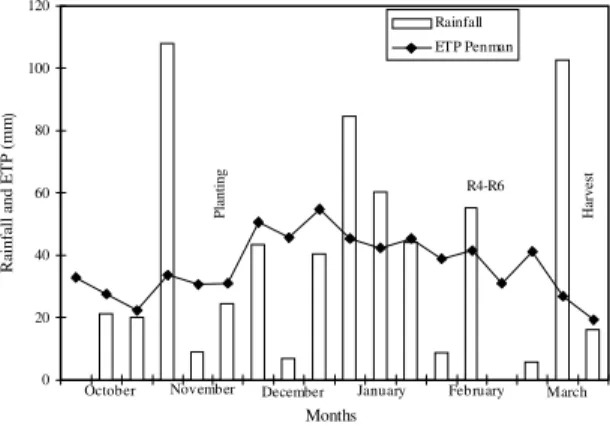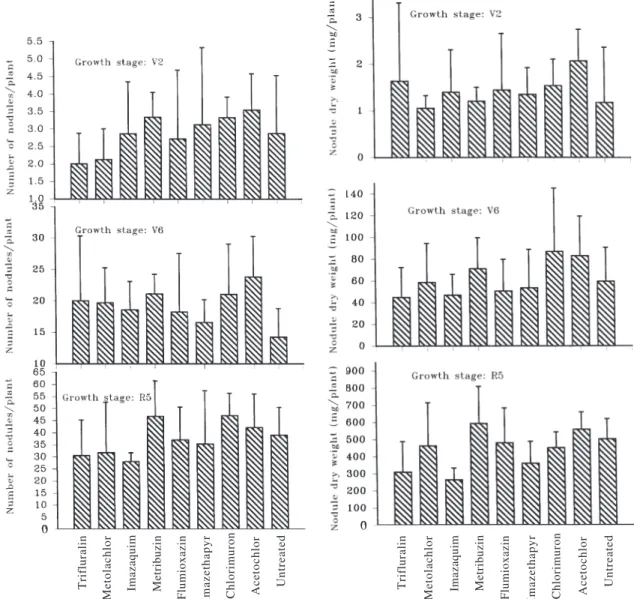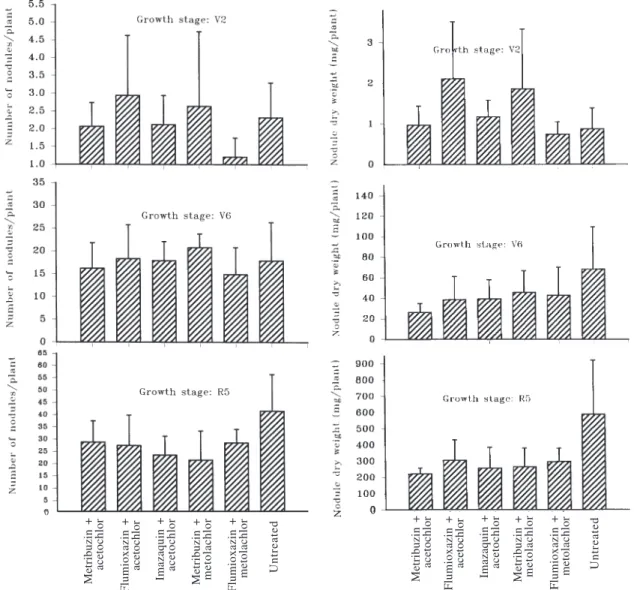EFFECT OF SOIL INTERACTING HERBICIDES ON SOYBEAN NODULATION
IN BALCARCE, ARGENTINA
1NORMA GONZALEZ2, JUAN JOSE EYHERABIDE3, MARIA IGNACIA BARCELONNA4,
ALFREDO GASPARI4 and SILVINA SANMARTINO5
ABSTRACT - Two trials were performed in Balcarce, Argentina (37° 45' LS; 58° 18' LW) during 1993-94, to assess the effect of eight herbicides applied individually or in tank mixtures, on nodule number, nodule dry weight, seed yield and N percent in seed in soybean Asgrow 3205, inoculated with Bradyrhizobium japonicum CB 1809. Individual herbicides and doses in kg ha-1 of a.i. were metribuzin (0.48), acetochlor (0.90), metolachlor (1), flumioxazin (0.075), trifluralin (0.96), imazaquin (0.20), imazethapyr (0.10) and chlorimuron ethyl (0.0125). The mixtures were metribuzin+acetochlor (0.48+0.9), flumioxazin+acetochlor (0.075+0.9), imazaquin+acetochlor (0.2+0.9), metribuzin+metolachlor (0.48+1.92), and flumioxazin+ metolachlor (0.075+1.92). A control treatment without herbicides was included. Both trials were laid out as randomized complete blocks with four replicates, on a loam illitic thermic petrocalcic Paleudoll, 5.7% organic matter (OM), 25% clay, 30.4 cmol kg-1 CEC. Nodules were sampled at V2 (second node), V6 (sixth node) and R5 (beginning seed) growth stages. Herbicides did not significantly affect the beginning of nodulation or nodule number and mass at R5, not either grain yield or N accumulation. This indicates lack of interference between soil interacting herbicides and N fixation in the high organic matter, loam soils of SE Buenos Aires province, even though a tendency in less number and dry weight of nodules was evident at the two latter growth stages.
Index terms: Bradyrhizobium japonicum, herbicides injury, nitrogen fixation, yield.
EFEITO DE ALGUNS HERBICIDAS QUE INTERAGEM COM O SOLO,
SOBRE A NODULAÇÃO DA SOJA EM BALCARCE, ARGENTINA
RESUMO - Durante 1993-94 realizaram-se dois experimentos em Balcarce, Argentina (37° 45' LS; 58° 18' LO) para avaliar o efeito de oito herbicidas, aplicados isoladamente ou em misturas, sobre o número e peso de nódulos, rendimento e percentagem de N nos grãos de soja Asgrow 3205 que receberam inoculação da estirpe CB1809 de Bradyrhizobium japonicum. Os herbicidas aplicados
isoladamente e suas doses em kg ha-1 de i.a. foram metribuzin (0,48), acetochlor (0,90), metolachlor (1), flumioxazin (0,075), trifluralin (0,96), imazaquin (0,20), imazathapyr (0,10) e chlorimuron ethyl (0,0125). As misturas foram metribuzin+acetochlor (0,48+0,9), flumioxazin+acetochlor (0,075+0,9), imazaquin+acetochlor (0,2+0,9), metribuzin+metolachlor (0,48+1,92), e flumioxazin+metolachlor (0,075+1,92). Incluiu-se um controle sem herbicidas. Os experimentos foram conduzidos no delineamento em blocos completos ao acaso, com quatro repetições. Usou-se um solo Paleudol petrocálcico, franco, ilítico, térmico, com matéria orgânica 5,7%, argila 25%, e CTC 30,4 cmol kg-1. Os nódulos foram amostrados em V2 (segundo nó), V6 (sexto nó) e R5 (começo de semente). Os herbicidas não alteraram o início da nodulação nem o número ou peso dos nódulos em R5, e também não houve efeito no rendimento de grãos, o que sugere que não há interferência entre eles e fixação de N nos solos francos com alto conteúdo de matéria orgânica do sudeste de Buenos Aires. Por outro lado, evidenciou-se uma tendência à formação de menos nódulos e menor peso dos nódulos, nos dois últimos níveis de crescimento.
Termos para indexação: Bradyrhizobium japonicum, lesões por herbicidas, fixação de N, rendimento.
1Accepted for publication on June 5, 1998.
2Agronomist, M.Sc., INTA, Estación Experimental
Agropecuaria de Balcarce, cc 276 (7620), Balcarce, Argentina. E-mail: ngonzalez@balcarce.inta.gov.ar
3 Agronomist, Profesor Asociado, Facultad de CienciasAgrarias,
Universidad Nacional de Mar del Plata, cc 276 (7620), Balcarce, Argentina.
4Agronomist, Facultad de Ciencias Agrarias.
5Profesora de Matemática, Profesora Adjunta, Facultad de
INTRODUCTION
Soybean (
Glycine max
(L.) Merrill.) is a crop of
major economic importance in Argentina, where
6 million ha are sown each year, with an average
yield of 2,370 kg ha
-1(Giorda, 1998). In the SE of
Buenos Aires province, 100,000 ha are used to
cul-tivate soybean, and this area has a potential yield of
5,500 kg ha
-1under intensive production (Andriani
et al., 1991). If this optimum yield could be
generalized, this region would be a major
contribu-tor to the national production. Since the crop has
been only recently included in crop rotations in this
region, its soils are devoid of
Bradyrhizobium
japonicum
. Hence, the inoculated seed has to
provide the incoming rhizosphere with enough
microorganisms to nodulate and fix nitrogen.
Under these conditions, the successful inoculation
is critical for the establishment of the symbiosis
(Rennie & Dubetz, 1984). The infective phase of
the symbiosis begins just before the contact occurs
between bacteria and root hairs (Fisher & Long,
1992) and during this period, the association is highly
sensitive to the soil environment (Keyser et al.,
1993). Not only
B. japonicum
survival but also the
whole sequence of events that culminate in
nodula-tion may be affected by changes in the soil
environ-ment. Herbicides in the soil, especially those applied
preplanting, preemergence and early postemergence
may exert adverse influences on the association,
depending on the chemical, doses and their
interac-tion with the soil properties (Duniganm et al., 1972;
Bollich et al.,1985). Since herbicides are necessary
to achieve maximum yields, their influence on
nodu-lation may conflict with the crop management.
The influence of herbicides on nodulation seems
to be closely related to the clay and organic matter
contents of the soil. Negative effects are associated
with sandy soils with less than 2% OM (Bollich
et al
.
, 1985; Moraes et al., 1989). As such effects
are site dependent, results ought to be drawn out from
experiments carried under field conditions, in the
same region in which those results will be applied
(Kucey et al., 1988).
Both broad leaves and grass weed seeds are
abundant in the soil seed bank in the SE of Buenos
Aires and weed competition with the crop can be
severe. For this reason herbicides mixtures are
rec-ommended to achieve optimum weed control
(Eyherabide, 1993, 1995). Although research has
demonstrated that individual herbicides applied to
the soil interfere with nodulation (Dunigan et al.,
1972 ; Bollich et al., 1985; Han & Oh, 1989; Moraes
et al., 1989; Akhtar et al., 1990; Dalton, 1992; Yueh
& Hensley, 1993), studies about the influence of
mixtures of herbicides on the association is scarce.
The present paper reports the results of two field
experiments aimed to assess the effect of eight
preplanting, preemergence or early postemergence
herbicides applied alone or in tank mixtures on the
nodulation, grain yield and grain N accumulation of
soybean growing on a high OM, loam soil from SE
Buenos Aires province, in Argentina.
MATERIAL AND METHODS
Field studies were conducted on a Balcarce loam (illitic thermic loam petrocalcic Paleudoll) (United States, 1996), at the Facultad de Ciencias Agrarias-Estación Experimental INTA Balcarce, at SE Buenos Aires province, Argentina (37° 45' LS; 58° 18' LW), during 1993-94. The soil characteristics were: pH 5.94; P 7.72 mg kg-1; organic matter (OM) 5.7%; cation
exchange capacity (CEC) 30.4 cmol kg-1; sand 34.7%,
silt 40% and clay 25.3%. Climatic information recorded during the soybean growth cycle is shown in Fig. 1 and Table 1.
Soybean cv. Asgrow 3205, inoculated with
Bradyrhizobium japonicum strain CB 1809 (109 colony
forming units/g inoculant) was sown on November 23, 1993 with a pneumatic seeder, delivering 32 seeds per meter at a depth of 2.5 cm. Both experiments were laid out as randomized complete block designs with four replicates. Plots were 7 m long x 2.8 m wide (4 rows spaced 0.7 m). In Experiment 1, herbicides and doses (kg ha-1 of i.a.) were as follows: imazaquin (0.20) was
(0.075+1.92), and imazaquin+acetochlor (0.2+0.9). All mixes were sprayed at preemergence, except imazaquin, which was applied 20 days before planting. Chemicals in both experiments were applied with a CO2 pressure
sourceknapsack plot sprayer, at 197 kPa, delivering 150 liter ha-1 through 11002 Teejet nozzles. Each
experi-ment included a control treatexperi-ment without herbicides.The remaining weeds in all plots were handpulled.
Nodule number and nodule dry weight were recorded at V2, V6 and R5 stages (Fehr & Caviness, 1977) from plants that were collected from a randomly selected 0.5 m long portion of a row. At harvest, grain yield and yield components were assessed from plants sampled from the central rows (2.8 m2). Nitrogen concentration in grain
was measured by semimicrokjeldhal digestion. Digests were analyzed in a Tecator Kjeltec Auto 1030 Analyzer. Data were subjected to analysis of variance. The assumptions underlying the analysis of variance were checked through residual analysis. Significance between means was tested using Duncan’s Multiple Range Test at P<0.05.
RESULTS AND DISCUSSION
The mean values for nodule number and nodule
dry weight per plant at V2, V6 and R5 are shown in
Figs. 2 and 3, from Experiment 1 and Experiment 2,
respectively. Assumptions underlying the ANOVA
were supported except in V2 data in which
homogeneity of variance was violated. Nevertheless
V2 data were subjected to analysis of variance since
the model was a balanced, fixed effects one in
which the F test is just slightly affected by non
homogeneity (Montgomery, 1984).
At R5, when maximum nodulation is
accom-plished by indeterminate soybean cultivars, nodules
number and dry weight per plant in the control plots
in both experiments suggest that no limitations
interferred with the expression of nodulation other
than chemical treatments. These results support
previous research data recorded in successful
inoculations under potential yield conditions at
Balcarce (González, 1994).
In both experiments there was no statistically
significant decrease in nodule number or nodule dry
weight per plant (P>0.05) caused by the
applica-tion of herbicides with respect to the control plots
values, except for nodule dry weight in Experiment
2 at R5 (P=0.048). However, there was a trend that
showed that nodule number and weight were lower
in the treated plots, especially in Experiment 2. In
Experiment 1, imidazolinones (imazaquin and
imazathapyr) and trifluralin gave the lowest values
of nodule dry weight at R5. These results show the
negative effect of the first group of herbicides on
nodulation, while trifluralin probably caused
damage to root development at early stages of plant
0 20 40 60 80 100 120
Rainfall and ETP (mm
)
Rainfall ETP Penman
October November December January February March Months
Planting
R4-R6
Harvest
FIG. 1. Rainfall and evapotranspiration (Penman) occurred during the soybean growth cycle.
Decades Months
November December January February March
1st 16.1 18.3 20.0 18.5 20.8
2nd 14.9 17.6 20.2 19.6 20.3
3rd 15.4 19.0 20.0 21.4 15.3
FIG. 2. Mean number and dry weight of nodules per plant of soybean cultivar A3205 inoculated with
Bradyrhizobium japonicum CB 1809 at second node (V2), sixth node (V6) and beginning seed (R5)
affected by herbicides applied alone. Vertical bars are the standard error of means.
growth (Rennie & Dubetz,1984; Al-Gubouri
& Habib, 1987; Yueh & Hensley, 1993).
The characteristics of the soil in which the
ex-periments were carried out (high organic matter and
clay content), may have been responsible for the
mild effect herbicides had on nodulation through
adsorption phenomena mediated by the soil colloids.
Besides that, this type of soil exhibited a developed
microbial biomass whose metabolism could
enzimatically degrade the herbicides, causing a
dilution effect on the applied doses (Dunigan et al.,
1972; Moyer, 1979; Bollich et al., 1985).
Even though both experiments were not
statisti-cally comparable, results indicate that the
applica-tion of mixtures of herbicides may exert a greater
detrimental effect on nodulation than those sprayed
alone.
Acetochlor Untreated
0
Trifluralin
Metolachlor Imazaquim Metribuzin Flumioxazin Imazethapyr Chlorimuron
0
Trifluralin
Metolachlor Imazaquim Metribuzin Flumioxazin Imazethapyr Chlorimuron Acetochlor
FIG. 3. Mean number and dry weight of nodules per plant of soybean cultivar A3205 inoculated with
Bradyrhizobium japonicum CB 1809 at second node (V2), sixth node (V6) and beginning seed (R5)
affected by herbicides applied in tank mixtures. Vertical bars are the standard error of means.
There were no significant differences between the
treatments in grain yield or yield components,
(P>0.05) as a consequence of herbicide application
in any experiment (Table 2). Neither N percent nor
N yield in soybean seed were affected by the
appli-cation of herbicides at any of the experiments in
relation to the control plots (Table 2). Differences
in nodulation atributes between treated and control
plots (Figs. 2 and 3) were not evident on yield
or N accumulation, probably because the soybean
plants assimilated more soil N to compensate
for eventually lower N
2fixation rates as
demonstrated by Rennie et al. (1982) and Rennie
& Dubetz (1984).
Treated plots in Experiment 1 yielded about 10%
more than those in Experiment 2. Average N
accu-N
Metribuzin + acetochlor
Flumioxazin + acetochlor Imazaquin + acetochlor Metribuzin + metolachlor Flumioxazin + metolachlor
Untreated
0
Metribuzin + acetochlor
Flumioxazin + acetochlor Imazaquin + acetochlor Metribuzin + metolachlor Flumioxazin + metolachlor
Untreated
Treatment Seed yield Seed N (kg ha-1) Pod number(106 ha-1) Seed number(106 ha-1) (g 1000 seedsSeed weight-1)
(%) (kg ha-1)
Experiment 1
Trifluralin 2941 8.216 17.812 169.28 4.93 136
Metolachlor 3127 8.770 18.181 176.37 5.10 147
Imazaquin 2889 8.042 17.120 175.57 5.04 130
Metribuzin 3057 8.119 17.787 175.91 5.15 143
Flumioxazin 3020 8.520 18.039 174.24 5.16 136
Imazathapyr 3031 8.359 18.289 174.20 5.23 139
Chlorimuron ethyl 3038 7.864 17.555 180.48 4.90 143
Acetochlor 2894 7.903 17.276 173.88 5.28 139
Control 2689 6.308 13.950 185.12 4.99 123
C. V. (%) 10.17 11.94 12.31 4.66 12.69
F test (p value) 0,717 0,074 0,327 0,153 0.335 0.661
Experiment 2
Metribuzin + acetochlor 2700 7.604 16.196 173.37 4.91 115
Flumioxazin + acetochlor 2678 7.212 15.795 167.80 4.84 112
Imazaquin + acetochlor 2803 7.887 16.799 168.89 5.05 123
Metribuzin + metolachlor 2657 7.778 16.567 167.23 4.81 111
Flumioxazin + metolachlor 2540 7.203 15.847 166.94 4.81 106
Control 2708 8.055 16.674 171.73 5.17 121
C. V. (%) 11.01 8.97 10.71 5.54 6.24 13.6
F test (p value) 0.88 0.41 0.93 0.89 0.49 0.65
mulation in seed of soybean treated with herbicides
alone was 18% higher than that accumulated in seeds
of plants treated with mixtures of herbicides. This
seemed to be a direct consequence of the yields
achieved in each case since seed N concentration
was nearly the same in both experiments. These
re-sults suggest that the combination of two herbicides
could eventually cause more damage than the use
of just one.
CONCLUSION
1. Herbicides that have been used during several
years and those of recent development such as
flumioxazin, imazethapyr, or imazaquin, sprayed
alone at the recommended rates can be used for weed
control in soybean in the south eastern area of Buenos
Aires Province, without diminishing yields because
of their influence on nodulation.
2. Same herbicides as above, sprayed in tank
mixes at the recommended rates do not show either
any significant effect on nodulation or N fixation
that may cause influence on soybean grain yield.
REFERENCES
AKHTAR, M.; AFGHAN, S.; MAHMOOD, T.; ABBAS, G. Effect of pre and post emergence weedicides application on nodulation growth and yield of soybean at different fertility levels.
Journal of Agricultural Research Lahore, v.28,
p.29-37, 1990.
AL-GUBOURI, A.A.; HABIB, S.A. Effect of some herbicides on nodulation of soybean (Glycine max
Resources Research, Plant Production, v.6,
p.11-26, 1987.
ANDRIANI, J.M.; ANDRADE, F.H.; SUERO, E.E.; DARDANELLI, J.L. Water deficits during reproductive growth of soybeans. I. Their effect on dry matter accumulation, seed yield and its components. Agronomie, v.11, p.737-746, 1991.
BOLLICH, K.P.; DUNIGAN, P.E.; JADI, M.W. Effects of seven herbicides on N2 (C2H2) fixation by soybeans. Weed Science, v.33, p.427-430, 1985.
DALTON, D.A. Effects of paraquat on the oxygen free radical biology of soybean root nodules. Bulletin of Environmental Contamination and
Toxicology, v.48, p.721-726, 1992.
DUNIGAN, E.P.; FREY, J.P.; ALLEN, L.D.; MCMAHON, A. Herbicidal effects on the nodula-tion of Glycine max (L.) Merrill. Agronomy
Journal, v.64, p.806-808, 1972.
EYHERABIDE, J.J. Evaluation of pre-emergent applica-tions of flumioxazin alone and with imazaquin and imazethapyr against weeds in soybeans. Tests of Agrochemicals and Cultivars no 14. Annals of
Applied Biology, v.122, p.62-63, 1993. Suppl.
EYHERABIDE, J.J. Evaluation of pre-emergent herbicides applications against Digitaria sanguinalis
in no tillage soybeans. Tests of Agrochemicals and Cultivars no 16. Annals of Applied Biology, v.126, p.66-67, 1995. Suppl.
FEHR, W.R.; CAVINESS, C.E. States of soybean
development. Ames: Iowa State Univ., 1977. 12p.
(Iowa Cooperative Extensive Service. Special Report, 80).
FISHER, R.F.; LONG, S.R. Rhizobium-plant signal
exchange. Nature, v.357, p.655-659, 1992.
GIORDA, L.M. La soja en la Argentina. In: GIORDA, L.M.; BAIGORRI, H.E. (Eds.). El cultivo de la
soja en la Argentina. San Juan: INTA, 1998.
p.11-26.
GONZÁLEZ, N.S. Dinámica de la fijación de nitrógeno en soja, en suelos con alta fertilidad
nitrogenada. Mar del Plata: Universidad Nacional
de Mar del Plata, Facultad de Ciencias Agrarias, 1994. 62p. Tesis Magister Scientiae.
HAN, Y.S.; OH, J.H. Effects of herbicide application on growth and the nodulation in soybean.
Korean Journal of Crop Science, v.34, p.303-309,
1989.
KEYSER, H.H.; SOMASEGARAN, P.; BOHOLOOL, B.B. Rhizobial ecology and technology. In: METTING JUNIOR, B. (Ed.). Soil microbial
ecology. New York: Marcel Dekker, 1993.
p.205-226.
K U C E Y , R . M . N . ; C H A I W A N A K U P , P . ; ARAYANGKOOL, L.; SNITWONGSE, P.; SIRIPAIBOOL, N.; WADISIRISUK, P.; BOONKERD, N. Nitrogen fixation (15N dilution) with soybeans under Thai field conditions. Plant
and Soil, v.108, p.87-92, 1988.
MONTGOMERY, D.C. Design and analysis of
experi-ments. New York: John Wiley & Sons, 1984. 537p.
MORAES, R.; LOPES, N.F.; SILVA, E.A.M. da; RODRIGUES, J.J. do. Tolerance and nodulation in soybeans (Glycine max (L) Merrill) cultivated on
two substrata and treated with four doses of metribuzin. Revista Ceres, v.36, p.492-506, 1989.
MOYER, J.R. Soil organic matter, moisture, and tempera-ture: effect on wild oats control with trifluralin.
Canadian Journal of Plant Science, v.59,
p.763-768, 1979.
RENNIE, R.J.; DUBETZ, S. Effect of fungicides and her-bicides on nodulation and N2 fixation in soybean fields lacking indigenous Rhizobium japonicum.
Agronomy Journal, v.76, p.451-454, 1984.
RENNIE, R.J.; DUBETZ, S.; BOLE, J.B.; MUENDEL, H.H. Dinitrogen fixation measured by 15N isotope dilution in two Canadian soybean cultivars.
Agronomy Journal,v.75,p.640-644, 1982.
UNITED STATES. Department of Agriculture, Soil Survey Staff. Key to Soil Taxonomy. 7.ed. Washington DC: U.S. Government Printing Office, 1996. 644p.
YUEH, L.Y.; HENSLEY, D.L. Pesticide effect on acetylene reduction and nodulation by soybean and lima bean. Journal of the American Society for


